Raytheon (Texas Instruments) AGM-88 HARM
Northrop Grumman AGM-88E/G AARGM
Northrop Grumman AGM-88J SiAW
The AGM-88 HARM (High-Speed Anti-Radiation Missile) is currently the standard U.S. anti-radiation missile, and also widely used by other countries. It has completely replaced the earlier AGM-45 Shrike and AGM-78 Standard ARMs.
Because of the less than satisfactory performance of the AGM-45 Shrike and AGM-78 Standard ARM in Vietnam, the Naval Weapons Center started a program in 1969 to develop a new anti-radiation missile. A major development goal was a high-speed missile (because this gave enemy radar operators less time to shut down their emitters), and therefore the project was named HARM (High-Speed Anti-Radiation Missile). Other goals included broadband seekers, a large warhead, operational flexibility, and high reliability. In 1970, the designation ZAGM-88A was allocated to the projected missile.
Because of the ambitiuos specifications, development was slow. In 1974, Texas Instruments was announced as prime contractor for the HARM, and the first flight of an AGM-88A missile occurred in 1975. Various problems were encountered in the development of the seeker and guidance system, including inability to distinguish between emissions from behind and in front of the aircraft. In early 1980, the problems were essentially solved, and in 1981, the initial production contract was awarded to Texas Instruments. The first production AGM-88A missiles were delivered in 1983, and HARM reached IOC (Initial Operational Capability) with the U.S. Navy in 1985, and the USAF in 1987. The first operational use of HARM occurred in April 1986, when the type was used to destroy Libyan radars.
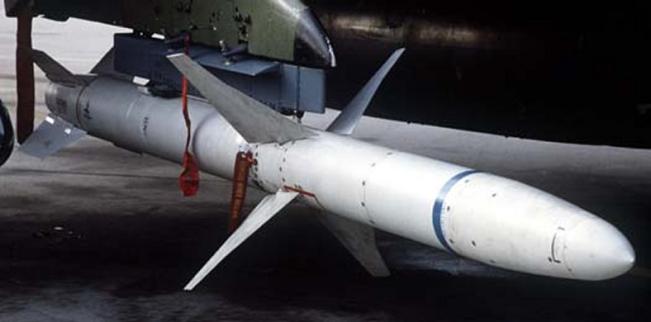 |
| Photo: via FAS |
| AGM-88A |
The AGM-88A missile is powered by a Thiokol SR113-TC-1 dual-thrust (boost/sustain) low-smoke solid-fueled rocket motor, and has a 66 kg (146 lb) WDU-21/B blast-fragmentation warhead (25000 steel fragments) in a WAU-7/B warhead section. The warhead is triggered by an FMU-111/B laser proximity fuze. The seeker of the WGU-2/B guidance section has to be pre-tuned to likely threats at depot-level maintenance, so every base or ship has to store a selection of differently tuned HARM seeker heads. In flight, the AGM-88 is controlled by the WCU-2/B control section using four movable BSU-59/B mid-body fins, and stabilized by the fixed BSU-60/B tailfins.
The HARM can be used in three different operational modes, known as Pre-Briefed (PB), Target Of Opportunity (TOO), and Self-Protect (SP). In PB mode, the long range (up to 150 km (80 nm)) of the AGM-88 is used to launch the missile on a lofted trajectory toward a known threat. When the HARM reaches lock-on range, and detects the radar emission, it can home on the target. If the target radar has been switched off before any lock could be acquired, the missile destroys itself to avoid possible friendly casualties by the impact of the now unguided missile. In SP mode, the aircraft's radar warning receiver is used to detect enemy emissions. The CP-1001B/AWG HARM Command Launch Computer (CLC) then decides which target to attack, transmits the data to the missile, and launches the AGM-88. TOO mode means that the seeker of the AGM-88 itself has detected a target, and the missile can be fired manually if the radar emission is identified as a threat. In SP and TOO modes, the AGM-88 can even be fired at targets behind the launching aicraft, although this of course significantly reduces the missile's range. The AGM-88 missile has an inbuilt inertial system, so that whenever it has acquired a lock once, it will continue towards the target even if the emitter is shut down (although the CEP is larger in this case).
The ATM-88A is a training version with an inert WAU-11/B warhead section, the CATM-88A is used for captive (non-launching) flight training, and the DATM-88A is used for loading and handling training.
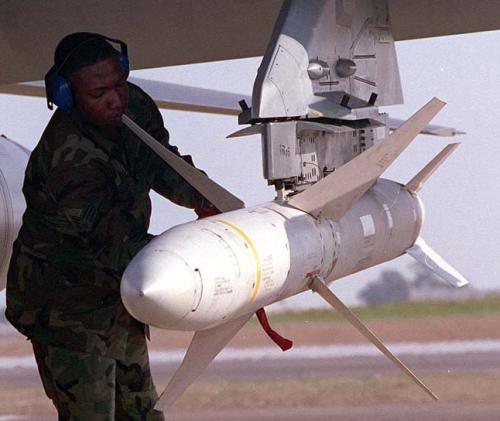 |
| Photo: via FAS |
| AGM-88A |
The original AGM-88A missiles were also classed as Block I. The AGM-88A Block II, introduced in 1986, had a new seeker with software in an EEPROM, which could be reprogrammed for new types of threats at short notice. In 1987, the production switched to the AGM-88B. This variant had the Block II seeker from the beginning, but had improved computer hardware in its WGU-2B/B guidance section, compatible with the forthcoming Block III software. This Block III update, available from 1990, improved the in-flight reprogramming (a.k.a. flexing) capabilities of the AGM-88B, as well as the PB mode targeting capabilities. The AGM-88B Block III was very widely and successfully used in the 1991 Gulf War, with more than 2000 HARMs fired at Iraqi radars. However, because the Block III update required fully powering up the missile, the U.S. Navy decided to retain its Block II missiles on aircraft carriers for safety reasons (powering up live missiles in the shops below deck was considered too risky). The ATM-88B, CATM-88B, and DATM-88B are the training variants of the AGM-88B, equivalent to the corresponding -88A versions
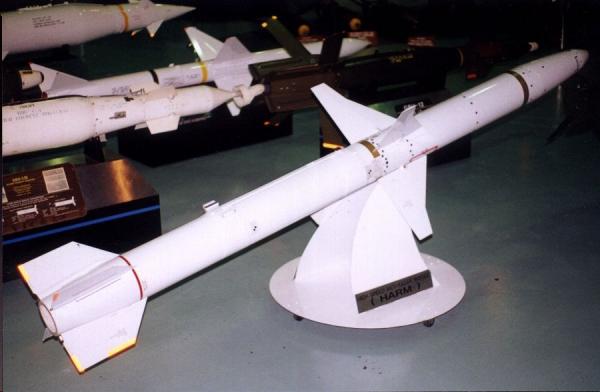 |
| Photo: Chris Timm |
| AGM-88B |
The next upgrade of the HARM produced the AGM-88C, which became operational in 1993. The major hardware improvement was a new WDU-37/B warhead with 12800 tungsten alloy fragments and a revised explosive charge, which significantly enhanced the lethality of the missile. The AGM-88C was initially produced with Block IV software in the upgraded WGU-2C/B guidance section. The WGU-2C/B used a single antenna instead of the previous two, and has a much more powerful signal processor. Block IV software was updated to counter the latest threats, and increased TOO mode capability by doubling the seeker range sensitivity. All AGM-88C production missiles were built by Texas Instruments as AGM-88C-1. The AGM-88C-2 by Loral, with an alternative low-cost seeker, was test-flown, but not produced in quantity. There are also ATM-88C and CATM-88C training variants of the AGM-88C (but apparently no DATM-88C).
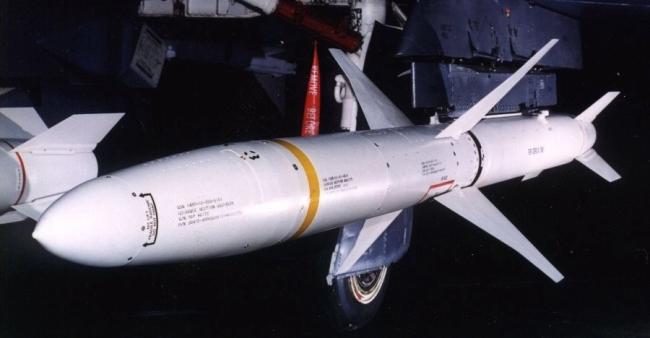 |
| Photo: Chris Timm |
| AGM-88C |
The next upgrade was a software update only, called Block V when applied to the AGM-88C Block IV, and Block IIIA, when applied to the older AGM-88B Block III. This update introduced home-on-jam capability, including the option to home on jammers which try to disrupt the ever more important GPS navigation system (used by many of the latest guided weapons). The U.S. Navy began to upgrade its HARMs to Block IIIA/V standard in early 2000. Block IIIA/V also allows the AGM-88B/C to be safely reprogrammed at sea.
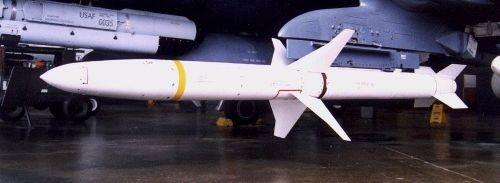 |
| Photo: Chris Timm |
| AGM-88C |
A significant upgrade effort for HARM was known as Block VI, an international collaboration by the U.S. (Raytheon), Germany (BGT), and Italy (Alenia). The main improvement of HARM Block VI was the incorporation of a GPS navigation system. This greatly increases accuracy when radar lock is lost after emitter switch-off, because the GPS guidance keeps the missile within a narrow box towards the last known emitter position. This is especially desirable in wars, where enemy radar installations are deliberately placed near sensitive civilian areas, like schools or hospitals. This often prevented the use of earlier HARM missiles in the Kosovo campaign, because a deviation after radar loss could lead to unacceptable collateral damage. Using GPS guidance as a primary means of homing on the target, Block VI HARMs could even be used as general purpose high-speed precision ground attack missiles. AGM-88Cs upgraded to Block VI standard were to be known as AGM-88D in U.S. service. Germany and Italy, which mainly have older AGM-88Bs in stock, will refer to their upgraded missiles as AGM-88B Block IIIB. The AGM-88D was in the EMD phase in 2002, and IOC at that time was planned for 2003. However, the AGM-88D program was terminated before production began.
A more advanced HARM update program is known as AGM-88E AARGM (Advanced Anti-Radiation Guided Missile). The AARGM is a further improved Block VI missile, which uses not only the AGM-88D's GPS but also an MMV (Millimeter Wave) active radar seeker for terminal homing in its new WGU-48/B guidance section. The MMW seeker will employ active target recognition algorithms, and therefore be able to strike not only the radar emitter, but also e.g. the control vehicle of the site. The program started at the NWC (Naval Weapons Center) China Lake in 1998, and in March 2000, the first test firing of the MMW seeker in a modified HARM was successful. AARGM development continued with modified AGM-88 missiles, and an SD&D (System Development & Design) contract for the production AARGM was awarded to ATK (Alliant Techsystems Inc.) in June 2003. The first AGM-88E flight test of the DT (Developmental Testing) phase occured in May 2007. LRIP (Low Rate Initial Production) began in 2008, IOC was declared in 2009 and full-rate production in 2012. After its acquisition of Orbital ATK, Northrop Grumman is now the prime contractor for the AGM-88E. The CATM-88E is the captive-carry training variant, while the DATM-88E is the inert ground-handling trainer.
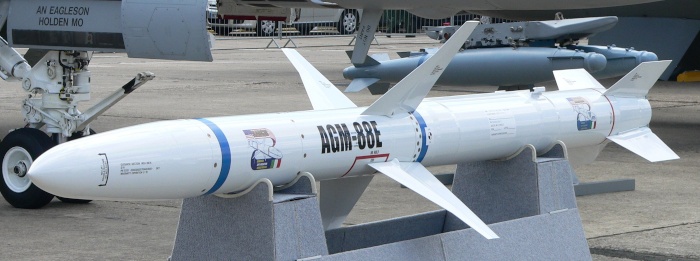 |
| Photo: David Monniaux, License CC BY-SA 3.0 |
| AGM-88E |
The AGM-88F was an improved HARM developed by Raytheon, which added a GPS/INS navigation system to AGM-88B/C missiles. It was evaluated by the USAF, but apparently not acquired in significant numbers. The latest variant is the AGM-88H for a FMS (Foreign Military Sales) program, but further details are not available.
In 2022, the Navy began to convert surplus AGM-88B missiles to AQM-88A SALT (Supersonic Air-Launched Target) configuration. The AQM-88A uses the control section of the AGM-88E AARGM, inert guidance and warhead sections, and telemetry and flight termination systems. The missile is to fill the gap left by expending the last remaining AQM-37D targets in September 2022. The Navy plans to procure at least 50 AQM-88A targets.
Currently, the primary U.S. carrier aircraft for the AGM-88 are the USAF's F-16C Block 50 (equipped with the AN/ASQ-213 HARM Targeting System) and the USN's F/A-18, EA-18G and F-35. The main launcher for the AGM-88 is the LAU-118/A. More than 21000 AGM-88 missiles of all variants have been built so far. Current HARM production is limited to new guidance sections and warheads, to allow the upgrade of older AGM-88A rounds to the latest standards. AARGM is in full production, with more than 2000 rounds on order.
AARGM-ER
In 2015, the U.S. Navy began the AGM-88G AARGM-ER (AARGM Extended Range) program. The new missile used the existing guidance section and warhead of the AGM-88E AARGM in a redesigned airframe with a new propulsion section. The new airframe allows internal carriage in the F-35, while the new dual-thrust rocket motor approximately doubles the range of the missile. The USAF later joined the program, and LRIP was started in 2021. IOC was at one time expected for 2023, but has been delayed to at least 2026. The designation CATM-88G has been assigned to a captive-carry training version of the AGM-88G.
 |
| Photo: cpm / André Forkert |
| AGM-88G |
SiAW
The U.S. Air Force started the SiAW (Stand-in Attack Weapon) program in 2022. The requirement called for a new air-to-ground missile to attack air-defense sites, surface-to-surface missile launchers, GPS-jammers and other high-value targets. After a competition between three competitors, Northrop Grumman was selected as the prime contractor in September 2023. NG's SiAW missile is a direct development of the AGM-88G AARGM-ER with essentially the same external shape, and in 2024, it was designated as AGM-88J. No details about the propulsion, guidance system and terminal seekers of the AGM-88J are available.
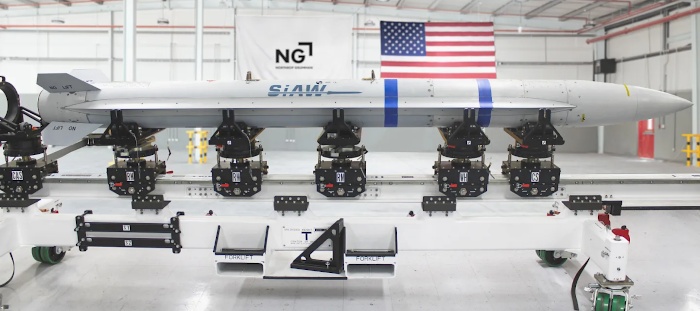 |
| Photo: Northrop Grumman |
| AGM-88J |
Flight testing of the AGM-88J by the USAF began in November 2024, and IOC was planned for 2026.
Specifications
Note: Data given by several sources show slight variations. Figures given below may therefore be inaccurate!
Data for AGM-88A/B/C/E/G:
| AGM-88A/B/C/E | AGM-88G | |
|---|---|---|
| Length | 4.17 m (13 ft 8 in) | 4.06 m (13 ft 4 in) |
| Wingspan | 112 cm (44 in) | n/a |
| Finspan | 61 cm (24 in) | ? |
| Diameter | 25.4 cm (10 in) | 29.2 cm (11.5 in) |
| Weight | 360 kg (800 lb) | 467 kg (1030 lb) |
| Speed | Mach 2+ | |
| Range | 150 km (80 nm) | 300 km (160 nm) |
| Propulsion | Thiokol SR113-TC-1 solid-fueled rocket | Northrop Grumman SR131-NG-1 solid-fueled rocket |
| Warhead | AGM-88A/B: 66 kg (146 lb) WDU-21/B blast-fragmentation AGM-88C/E: WDU-37/B blast-fragmentation | WDU-37/B blast-fragmentation |
Main Sources
[1] Anthony Thornborough: "Iron Hand", Sutton Publishing, 2001
[2] Norman Friedman: "US Naval Weapons", Conway Maritime Press, 1983
[3] Norman Friedman: "World Naval Weapons Systems, 1997/98", Naval Institute Press, 1997
[4] Bill Gunston: "The Illustrated Encyclopedia of Rockets and Missiles", Salamander Books Ltd, 1979
[5] Hajime Ozu: "Missile 2000 - Reference Guide to World Missile Systems", Shinkigensha, 2000
[6] Bernard Blake (ed.): "Jane's Weapon Systems 1987-88", Jane's, 1988
[7] "Navy Training System Plan for the AGM-88 HARM and AARGM Systems", U.S. Navy, 2002
[8] Various web resources, referenced by Wikipedia: AGM-88 HARM
[9] The War Zone, Joseph Trevithick:
First Stand-In Attack Missile Delivered To USAF
Back to Current Designations Of U.S. Unmanned Military Aerospace Vehicles
Back to Directory of U.S. Military Rockets and Missiles
Last Updated: 19 February 2025